Contents

Common, Danubian and Oriental bream is the only representative of the genus of bream and belongs to the carp family and to the cyprinoid order. Young breams are called scavengers, and adults are called chebak or keel. Naturally, adults weighing more than 1 kg are of the greatest interest.
Fish bream: description
Due to their unique appearance, an adult bream can be quite easily distinguished from a juvenile. The bream is able to grow in length up to 0,8 meters, with a weight of up to 6 kg.
Appearance
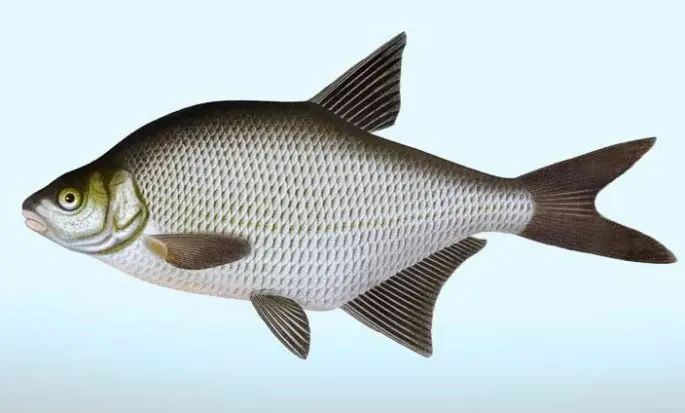
The bream differs from other types of fish in that it has a high body. As a rule, the height is up to 30% of the total length of the fish. In addition, the mouth and head of the bream are quite small, while the mouth of the bream ends in a kind of retractable tube. On the back is a short but high fin, consisting of a dozen soft rays.
Interesting fact! Breams are characterized by the fact that they have formed single-row pharyngeal teeth, five pieces on each side.
The anal fin of the fish begins immediately behind the back of the base of the dorsal fin and has three perceptibly hard and somewhat softer rays. Between the anal and pelvic fins there is a gap in the form of a keel, on which there are no scales. The dorsal region of adults is colored gray or brown, while the sides are golden brown, and the belly is a pronounced yellowish tint. All fins have the same gray shades with dark edging. Young individuals are distinguished by lighter, silvery tones.
Behavior and lifestyle
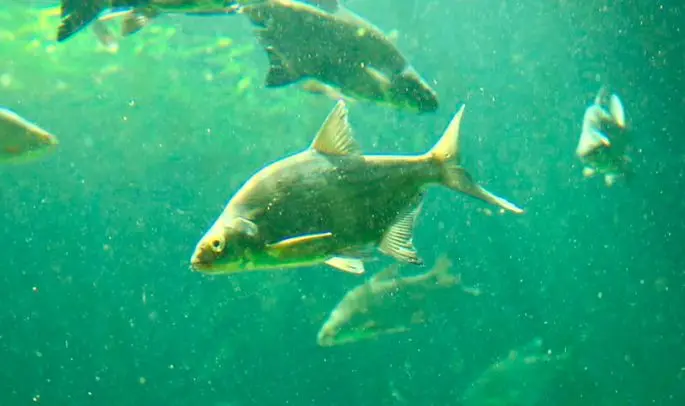
Bream is a rather cautious and shy fish, with excellent hearing, so this factor must be taken into account when catching bream. It prefers to live both in rivers and lakes, while it is also found in reservoirs. In the rivers, this fish rarely grows to an impressive size. The bream prefers to stay in flocks. At the same time, individuals of various ages can be present in the flock, from the smallest to the largest.
The bream’s mouth functions in such a way that it mainly feeds from the bottom. Therefore, we can safely say that bottom microorganisms form the basis of its diet. As a rule, bream feeds on larvae, shells, snails, and algae. Numerous flocks of bream quickly clear the bottom area. This contributes to the active movement of fish around the reservoir in search of food. The movement of the flock can be determined by the active release of swamp gas bubbles.
It is important to know! With the onset of dusk, the bream calmly approaches the coastline on the shallows to feed.
The bream can be found in areas where there is no strong current or there is no current at all. Therefore, the bream is found in backwaters, in deep pits, within the blockages of trees, next to steep banks, where a clay or muddy bottom prevails. Older individuals prefer not to come close to the coastline, but to stay at a considerable distance. The bream, on the contrary, comes close to the shore and prefers to stay in dense thickets of coastal vegetation. The bream hibernates in deep holes.
Life span of bream
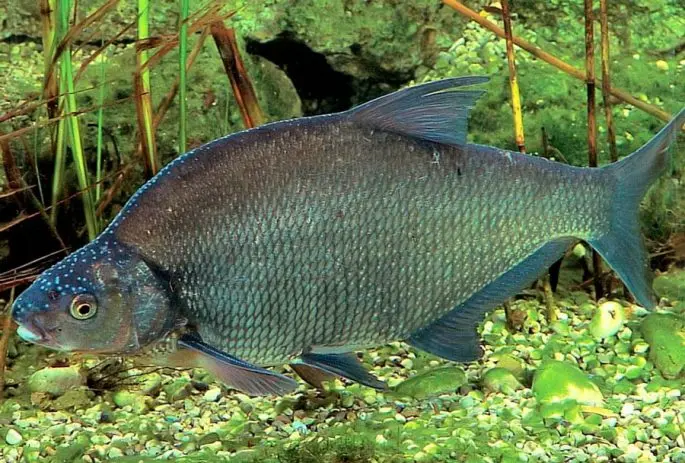
According to scientists, sedentary forms of bream live long enough, about 30 years. As for representatives of semi-anadromous forms, their life expectancy is 2 times less.
Habitat

In nature, bream is found in almost all water bodies of the central and northern parts of Europe.
Interesting to know! Bream is found even in the Urals, in the basins of such rivers as the Irtysh and Ob, including in Lake Baikal, as well as in the Krasnoyarsk reservoir.
The habitat of the bream is not limited to cold regions, since the bream is found in the basins of the Caspian, Black and Azov Seas. A considerable number of bream is located on the territory of Transcaucasia, in the Amur River basin, as well as in the southernmost provinces of China.
Bream diet
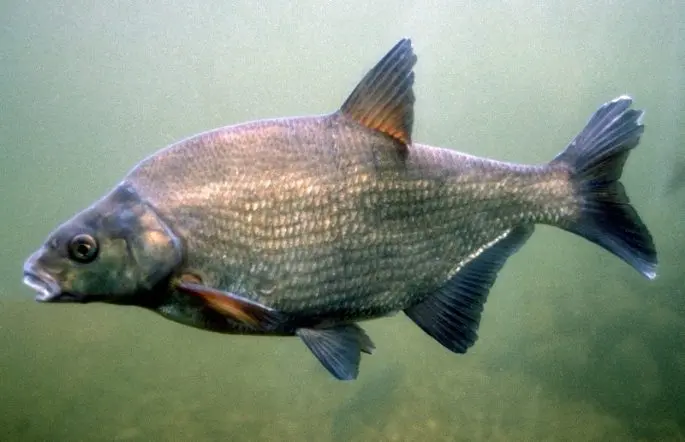
The most important component of the diet of bream, in addition to various small crustaceans, is bloodworm, which lives in the bottom soil. Due to the fact that breams have rather weak pharyngeal teeth, they prefer to feed on crustaceans and benthic invertebrates.
In addition, bream actively feed on aquatic vegetation as well. When a bream feeds, it absorbs all the necessary food components with water, which are then retained with the help of special outgrowths. Gill rakers are arranged in two rows along each gill arch. At the same time, the gill rakers, although short, are rather thick, with the presence of transverse canals. It is in the transverse channels that the necessary food objects settle. Water is subsequently pushed out through the gill covers.
Interesting to know! Bream is caught on baits of various origins, both animal and vegetable, or a combination of baits, the so-called “sandwiches”.
Therefore, we can safely say that the bream feeds mainly on small food objects, such as bloodworms and small crustaceans included in zooplankton. Such a diet of fish is associated with its anatomical structure, or rather, developed gill rakers with a special muscle. This muscle controls the work of the gill rakers. Such a unique mechanism allows breams to quickly become the dominant species in their natural environment, displacing fish such as roach or silver bream from their habitat.
Fish reaction to CORN
Best biting period
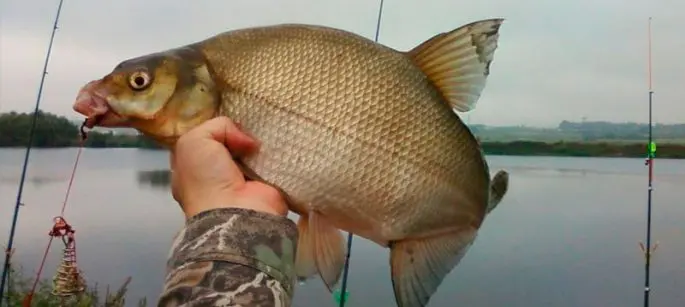
After spawning, it continues until half of June and from the beginning of August, almost the entire month. With the approach of autumn, at the end of September, when the bream gather in flocks, the biting resumes again, but to a greater extent depends on weather conditions.
Reproduction and offspring
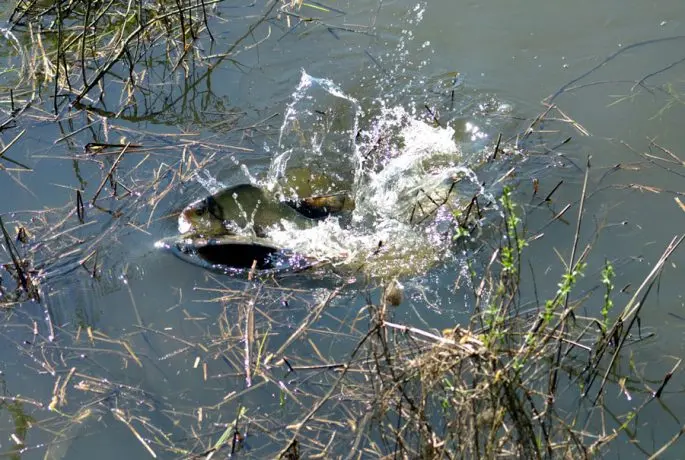
For the middle part of the territory of our country, it is characteristic that breams begin to spawn with the advent of the first days of May. By the beginning of spawning, flocks of breams are divided into groups according to age. A similar division applies to any species of schooling fish, while the bream change their color to a darker one. In the head area of males, relatively small warts appear, more like a rash.
Fish leave for spawning in groups, and each group leaves for spawning later than each previous one. Regardless of weather conditions or habitat, spawning lasts about a month. Bream spawning grounds are located in close proximity to normal habitats and are found in shallow areas with a grassy bottom. Males go to spawning grounds first, followed by females.
Each group spawns for several days, although much depends on the nature of habitats and weather conditions. Bream caviar has a slightly yellowish tint. An adult lays up to 150 thousand eggs at a time. Due to high fertility rates, the number of bream remains at a constant level, even under conditions of active industrial fishing.
The eggs are securely attached to the shoots of aquatic vegetation. Those eggs that could not resist, they float to the surface of the reservoir, where the same bird eats them. For the normal development of eggs, the water temperature should not fall below +10 degrees. In the event of a noticeable cooling, mass death of bream eggs is possible.
It’s important to know! Depending on climatic conditions, bream reach sexual maturity in different ways. In warmer regions, they are ready to spawn at the age of 3-5 years, and closer to colder regions, the age limits move apart, and the bream can mature at the age of 5 to 9 years.
After spawning, breams form numerous flocks and leave their traditional spawning grounds. Here, in the traditional areas of habitat, the bream will be until next spring, when the next stage of spawning begins. After spawning, the bream begins to actively feed. To do this, it accumulates in areas overgrown with reeds or moisture-loving grass. In such areas, the bream finds everything it needs for food.
Natural enemies of the bream
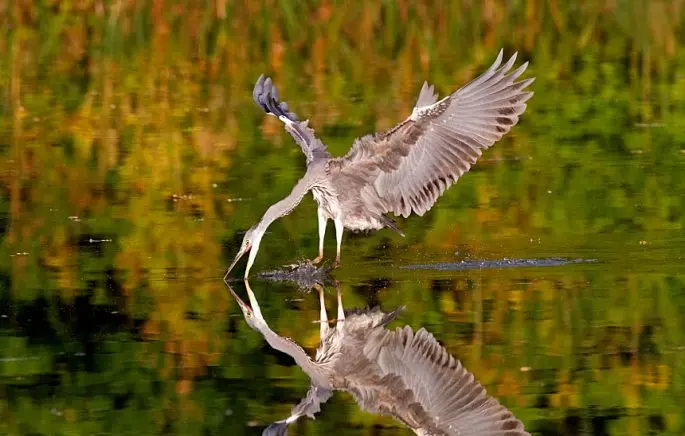
Breams are quite active and grow quickly, which gives them some privileges associated with risks, especially at a young age, when the fish are fairly easy prey for many predators.
Already in the 3rd year of life, the fish begins to get out from under the “press” of many predatory fish species, including pike. Despite this, some natural enemies still remain. It should be noted that catfish or large bottom pike, they still pose a certain danger even to adults. In addition, one more factor that poses a danger to the existence of bream should be noted – these are various parasites that can settle in the body of a bream. The eggs of these parasites enter the water with the faeces of many fish-eating birds. After being born, the parasites are swallowed by some small crustaceans, which, in turn, feed on bream. From the intestines, some types of parasites penetrate into the tissues of the fish, where they actively develop and often lead to the death of individuals.
Fish especially suffer in the summer, when the water warms up to a high temperature. During this period, the bream can be affected by tapeworm, as well as a severe form of fungal disease of the gills – bronchitis. As a rule, sick or weakened individuals become the prey of water body orderlies – large pikes and large gulls. They do not have a significant impact on the number of bream in water bodies.
Fishing for bream, how to catch bream, fishing for bream on the channel, good fishing
Population and species status
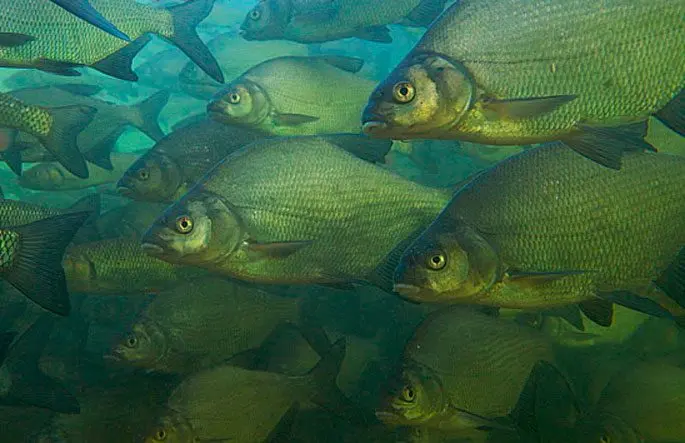
The number of breams in each particular water body can vary significantly, depending on the success of the spawning process. In order for semi-anadromous breams to successfully spawn, special natural conditions must be created for them, with a high flood. As a result of the regulation of the stack of many rivers, the number of natural areas for fish spawning has noticeably decreased. Unfortunately, this is true not only for bream, but also for other types of fish.
Important fact! The black Amur bream in our time has received the status of rare and endangered species, therefore it is listed in the Red Book.
In our time, measures are being taken to preserve the main stocks of bream, so a number of fish farms have been created. In addition, measures are constantly taken to save juvenile bream when the natural connection between the reservoir and the river is lost. To create comfortable conditions, special designs of floating spawning grounds are used. As mentioned above, the number of fish is not the last impact of various epidemics.
Fishing value
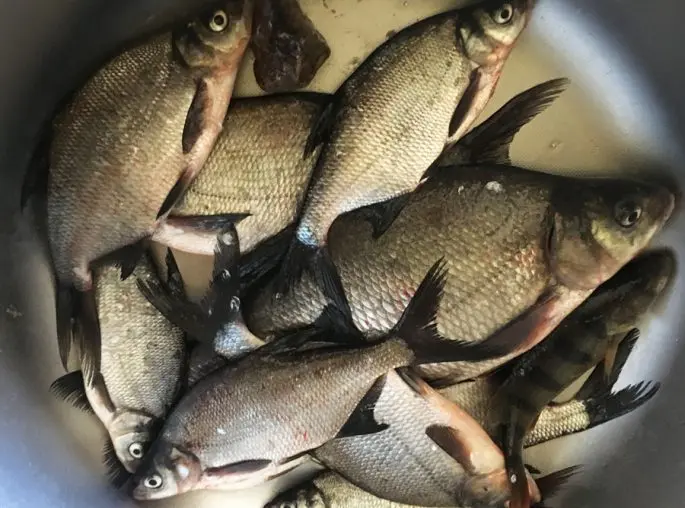
As a rule, bream is caught in the coastal zone and not at all in large batches. This is carried out both in spring and autumn, by mechanized fishing teams that use secrets and fixed nets. In the autumn period, loop seines are also used. Based on fishing regulations, a more rational approach to the use of the bream population is preferred. This is due to the reduction of the thickened pre-estuary space, as well as the expansion of the coastal fishing zone in the marine area. At the same time, the terms for the use of vents and secrets are limited, starting from the beginning of March and up to the 20th of April.
Starting from April 20 and until May 20, the terms of bream fishing in the river zones adjacent to the foredelta are officially extended. Such activities made it possible to increase the intensity of fishing activities related to the fore-delta, with an increase in the catch of river and semi-anadromous fish species, including bream. Despite the measures taken, many experts point to their insufficiency.
Useful properties of bream fish
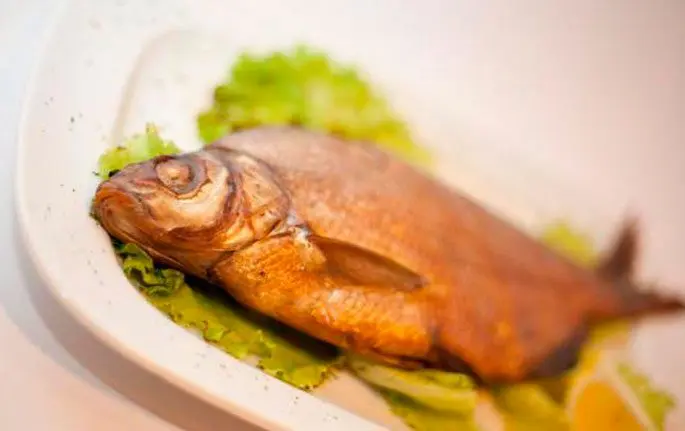
Large representatives of the carp family, especially the autumn catch, are considered the most acceptable catch among fishermen. According to some experts, bream is a thin and bony fish, but in fact, its meat contains up to 9 percent of healthy fat. Therefore, bream meat is tender and soft. In smaller individuals, the meat is really lean and dry, and the presence of a large number of bones makes it of less quality. The best is the Azov bream, caught in the fall, because it is a large and rather well-fed specimen.
What is most interesting, the bream is considered the fattest fish, which is second only to the beluga in these indicators. It is also believed that bream fat is the most useful, since it is not subjected to any processing, it is involved in the process of cleaning blood vessels, and vitamin D helps strengthen bones.
This is a unique product because it contains Omega-3 polyunsaturated fatty acids. It is these acids that lower the level of cholesterol in the blood and dissolve cholesterol plaques, cleansing the blood vessels, which, in turn, reduces the risk of heart and vascular diseases. Fish oil has no contraindications, except that personal intolerance to the product can become an obstacle to its use. There are very few such people on the planet.
In addition to useful fish oil, bream can become a source of vitamins and microelements, which are so necessary for the life of the human body.
For those who do not want to just eat fish oil, they can cook bream according to an excellent recipe based on olive oil and lemon-orange sauce.
To prepare this dish, you need to take dill and chop, then fill the inside of the fish with it. Then the juice of an orange and half a lemon is squeezed here. It is also necessary to pour the bream with a mixture of juices. After the fish has been infused for a couple of hours, olive oil is added on top and inside the bream. After that, the fish can be baked either in foil or in the oven. Additionally, fish can be stuffed with buckwheat porridge. This is a delicious old recipe that will not leave anyone indifferent.
In the case of cooking bream, it should be remembered that baked bream is considered the most delicious and healthy, but this does not mean at all that it cannot be cooked according to other recipes or technologies. Many people know what a delicious smoked bream is, but it is better to limit the use of such a product, as well as fried bream.
In conclusion
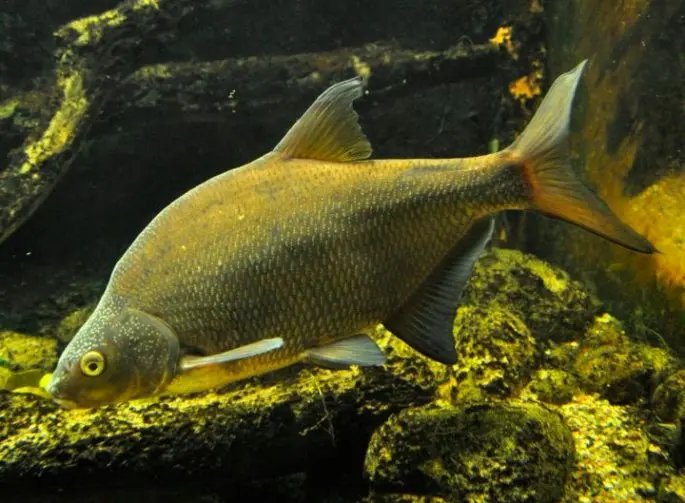
There are many interesting facts about the life of this fish. So, at the beginning of the 20th century, up to 20 million bream were caught annually in the Caspian Sea basin. What can not be said about our time, when the populations of various fish species are constantly declining. Catching a large bream is the ultimate dream of any amateur angler. Unfortunately, trophy specimens are quite rare these days. And the blame for everything is a person who pollutes the waters of reservoirs at a fast pace. In addition, the construction of various hydraulic structures on the rivers makes it impossible for fish to get to their natural spawning grounds. Therefore, fish have to spawn in uncomfortable conditions, which leads to poor survival of eggs. Especially recently, poachers have become very active, which cause significant damage to the number of bream, catching the largest, most productive individuals. At the same time, a trifle suffers from their activities, since these “fishermen” have the most “nasty” fishing weapons in their arsenal.
And yet, I would like to note more optimistic trends, since recently paid fishing has reached a new level. In addition to the fact that quantitative fishing is controlled in such ponds, the owners also breed various types of fish, including bream. This allows you to maintain the number of fish in such ponds at an optimal level.
Fortunately, there are still hard-to-reach places on the planet where the fish do not feel any noticeable “pressure” from fishing enthusiasts. Unfortunately, some elements of modern civilization are becoming more accessible to man, and he is increasingly trying to get into these places where the fish still feel more comfortable.
Fishing is, first of all, recreation and everyone strives for nature in order to replenish their strength and energy. Therefore, it is not surprising that on weekends the shores of reservoirs are simply plastered with lovers of fishing. Can it be banned? Hardly!!
Bream reaction to bait. School of fish. What do bream eat in winter? how to install the camera









